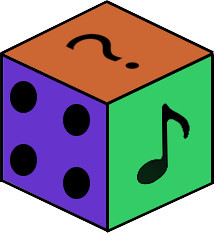
- Accompanist (role)
- Ad libitum
- Agenda
- Aleatoricism
- Aspect
- Balance
- Bartle types
- BCG
- (Cognitive) flow
- Conductor (role)
- Constellation
- Constructor (role)
- Co-optionality
- Cue cards
- Dice
- Dimension
- Downbeat
- Downtime
- Elegant Game
- Emergence
- End Condition
- Event (musical event)
- Extended technique
- Facilitator
- Fighting
- Flow
- Found sound
- Gameplay flow
- Genre
- Heteronomous Music
- Horizon of intent
- Improvisation rite
- Insert game
- Inspire cards
- Instrument Preparation
- Judge (role)
- Karaoke
- King-making
- Learning curve
- Ludomusical dissonance
- Meaningful Choice
- Mechanic
- Music game
- Non-idiomatic music
- Notation Cards
- Open work
- Parameter
- Pervasive Game
- Player (role)
- Prompter (role)
- Psychographics
- Quarterbacking
- Rhythm cards
- Rhythm game
- Roles
- RPG
- Rule Cards
- Speedrun
- Stacking
- Trading
- Transition
- Upgrade
- Victory condition
- Xenochrony
- XP
- Yes, and...
Cards that can be shown by the Conductor (or Prompter) to Players to cue the direction of improvisation.
Usage
Cue-cards can have many functions. They can signal a transition, a specific event or adjust a single aspect of music. Sets of cue-cards can focus on one of the functions or have them all mixed together.
Cue-cards are used for example in John Zorn's famous Cobra. He introduced a well-thought way of using cue-cards: first you put it up (as an "announcement") to let performers prepare. Then your downward vertical movement of the card signals the moment of applying the cue (a "downbeat"). This is not a standard, intuitive usage, but for some games it's the best to agree on that procedure.
Matt Butler (Everyone Orchestra) writes on a cue-card sized whiteboards (photo at Flickr) so having all the options open is also possible.
Simple activities
Unrestricted improvisation with cue-cards is a fun introductory activity on its own and can be done with many sets of cues. Try some additional ideas:
Shuffled Cues
Form a deck of cue-cards withholding one card: it should be a cue-card that can end the piece or single parts like "stop", "play quieter", "break down" or such.
The game will be played in a semi-circle with a central spot. Conductor draws 3 cards from the deck and adds the one "free" card described above to the set (for some types of cue-cards you may need more than 3). Now if cards are showed above the head they apply to the whole group, but they can be also pointed towards a specific player.
This game might be played with a timer and you may also agree on fluid changes of conductors.
Running Cues
For an energizing activity possible with different sets of cue-cards you can let all players sit in a circle but facing outwards. You will need space around the circle and a table for cue-cards laying at the disposal of the conductor who will show cues individually by walking or maybe even running around the circle.
Available sets (section in progress)
There are many different possible sets of pre-made musical cue-cards. Cues are quite often written (with large letters) in full-text or with abbreviation. There are advantages of using intuitive images for some of the cues instead of text as they are:
- language-independent
- easy to recognize regardless of orientation (e.g. upside down)
- faster to react to.
Many cues can be re-used in different music games, for that purpose let's gather them all here.
Downloads
Popular cues
- Play
- Slow down
- Speed up
- Next
- Volume up
- Volume down
- Pause
- Poisoned (do something crazy)
- Cut up (play slices)
- Copy
- Invert
Other props:
If you think anything should be added to this subpage, please drop a hint or a link for future editors.






